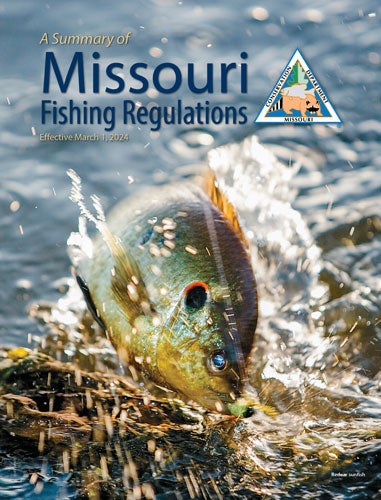Title
When and Where
Flathead catfish are typically inactive during daytime, so fishing at night with rod and reel or set lines is more productive. In medium sized streams, focus on areas near some type of cover such as drift piles, fallen trees and large rocks. In large rivers, fish the quiet water around cover, channel breaks, or wing dikes and deep water nearby. In large lakes, fish around standing timber or other cover, underwater humps and islands, and along submerged creek channels. Main lake points and sub points also hold flatheads during late spring when water temperatures are between 60 and 70 degrees.
Title
How
Flathead catfish clearly prefer live bait such as large minnows, goldfish, green sunfish, bullheads and crayfish. Anglers should use stout gear, strong line, and large hooks because flathead catfish are typically much larger than channel catfish.
This is the easiest catfish to catch because it lives in most publicly owned lakes, private ponds and streams in Missouri. Channel cats also range throughout a water body, and they readily take a variety of baits.
Title
When and Where
Larger channel catfish often spawn in late May through June along shorelines protected with rock riprap. This is a good place to fish when water temperatures reach 65 degrees.
Title
How
Common baits include a ribbed, rubber worm dipped in a commercially prepared bait, or night crawlers, chicken liver, grasshoppers, crayfish or small fish rigged on a straight, treble or circle hook. If you're using worms or dead or prepared baits with your rod and reel, cast or drop the line into the water, and tighten it when the bait hits the bottom. If you're using live bait on bank lines or floating jugs, keep it near the water surface. Trotlines, which have multiple drop lines, are very popular because they cover a wider area and multiple depths using a single line. Bank lines, jug lines and trotlines are typically fished overnight.
Title
When and Where
Fishing for blue catfish is limited to Missouri’s large reservoirs and rivers and a few small lakes. Fish areas near swift current and deep water in large rivers. These areas are typically found along the main channel near the tip of wing dikes or just downstream of locks and dams. Blue catfish are oftentimes found in large groups, and will sometime feed during the heat of the day along very shallow flats. Tailwater areas immediately below reservoir dams are also good for blue catfish, but they are usually limited to rod-and-reel fishing.
Title
How
Heavy gear should be used because blues weighing 20 to 50 pounds are common in some waters. Rod and reel, trotlines, and jug lines work best. Popular baits include live or dead fish, especially sunfish and goldfish, and cut baits, usually gizzard shad or skipjack herring. Juglines drifted over deeper sand flats often produce very good catches of blues. In large lakes blues can be found throughout the water column, so try fishing a variety of depths with live or cut fish on trotlines or jug lines.






















